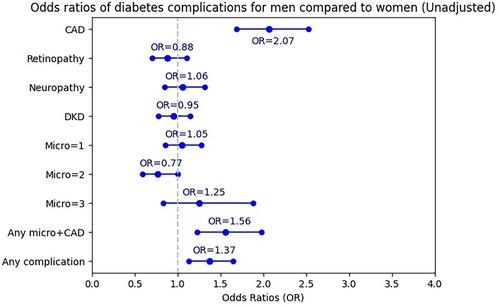This study aimed to assess and compare the prevalence of diabetes complications between men and women with Type 2 diabetes (T2D), as well as how gender relates to these complications.
In this cross-sectional study, complications of diabetes, including coronary artery disease (CAD), retinopathy, neuropathy and diabetic kidney disease (DKD), were evaluated in 1867 participants with T2D. Additionally, baseline characteristics of the individuals, including anthropometric measurements, metabolic parameters and the use of dyslipidaemia drugs and antihyperglycaemic agents, were assessed. Gender differences in complications were examined using the chi-squared test. Multivariate logistic regression was employed to investigate the relationship between gender and T2D complications, with and without adjusting for the characteristics of the studied population.
In the studied population, 62.1% had at least one complication, and complications were 33.5% for DKD, 29.6% for CAD, 22.9% for neuropathy and 19.1% for retinopathy. The prevalence of CAD and neuropathy was higher in men. However, DKD and retinopathy were more prevalent among women. Odds ratios of experiencing any complication, CAD and retinopathy in men compared with women were 1.57 (95% CI: 1.27–2.03), 2.27 (95% CI: 1.72–2.99) and 0.72 (95% CI: 0.52–0.98), respectively, after adjusting for demographic factors, anthropometric measures, metabolic parameters and the consumption of dyslipidaemia drugs and antihyperglycaemic agents.
The prevalence of diabetes complications was significantly higher in men with diabetes, highlighting the need for better treatment adherence. CAD was associated with the male gender, whereas retinopathy was associated with the female gender. Men and women with diabetes should be monitored closely for CAD and retinopathy, respectively, regardless of their age, diabetes duration, anthropometric measures, laboratory findings and medications.



